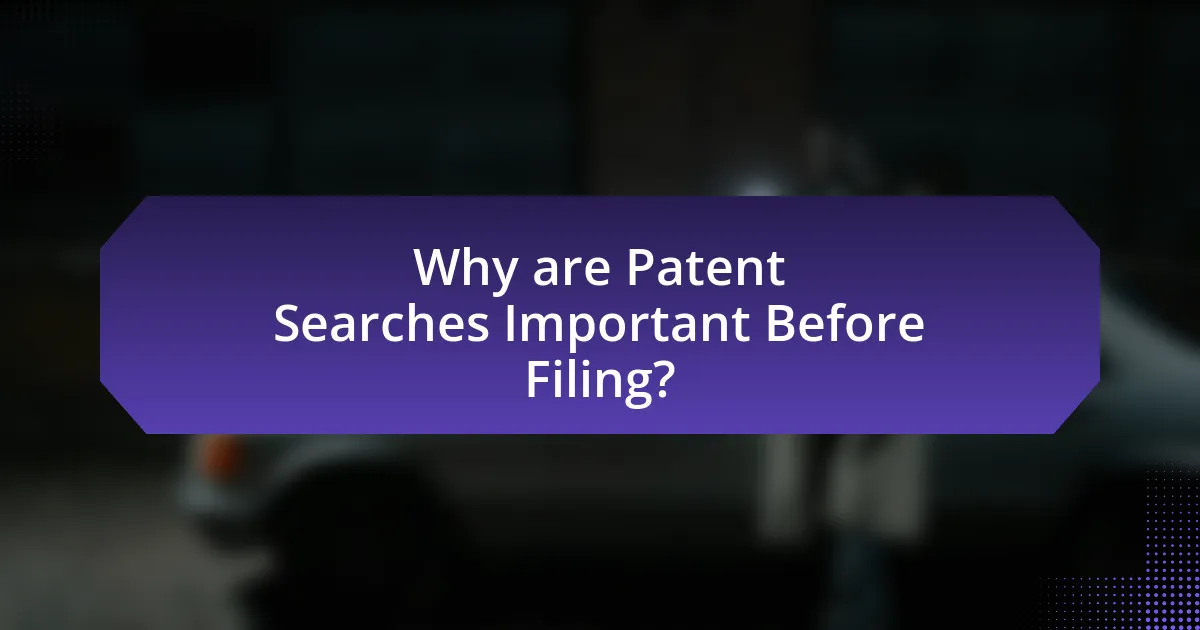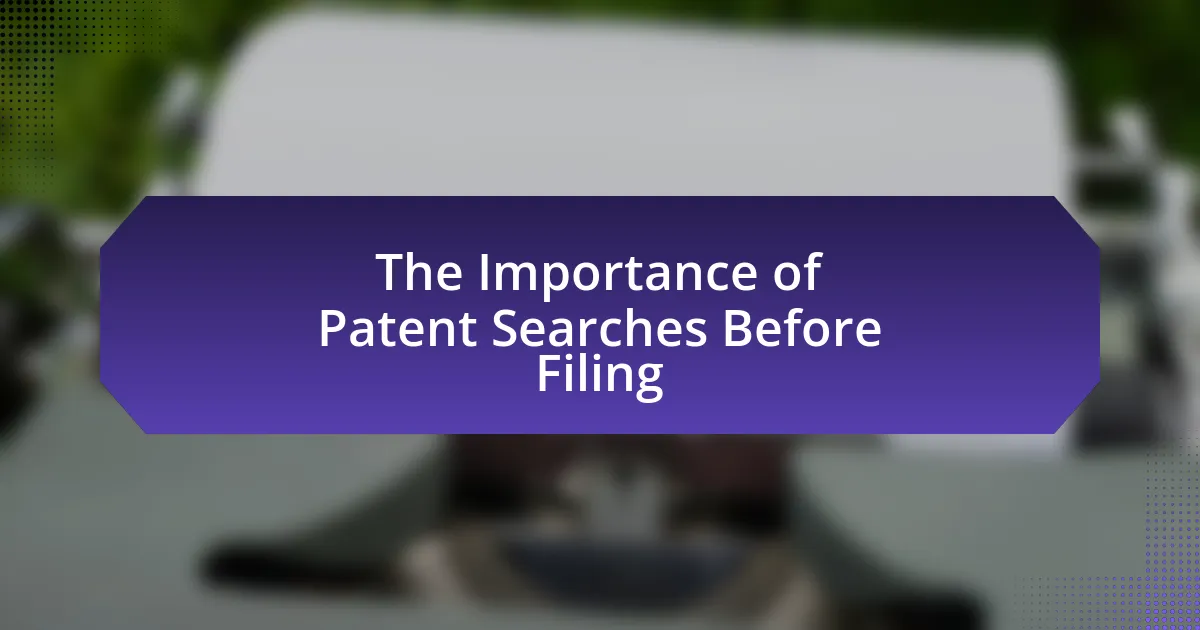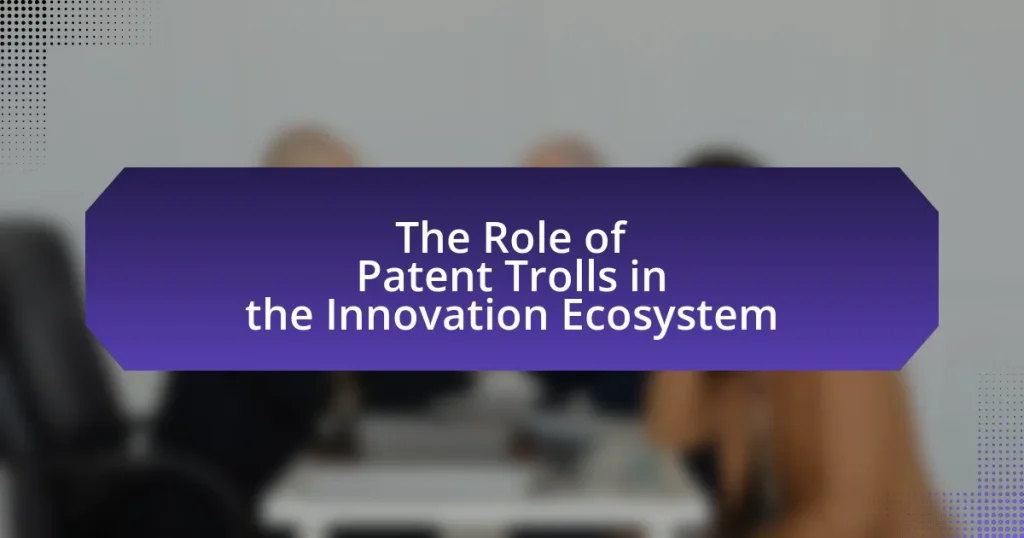The article emphasizes the critical importance of conducting patent searches before filing for a patent. It outlines how these searches help identify existing patents that may conflict with new inventions, thereby reducing the risk of infringement and increasing the likelihood of patent approval. Key topics include the purpose of patent searches, the risks associated with not performing them, and the various types of searches such as novelty, freedom-to-operate, and validity searches. Additionally, the article discusses best practices for conducting effective searches and interpreting results, highlighting the financial and legal implications of thorough patent research.

Why are Patent Searches Important Before Filing?
Patent searches are important before filing because they help identify existing patents that may conflict with a new invention, thereby reducing the risk of infringement. Conducting a thorough patent search allows inventors to assess the novelty of their idea and determine whether it is likely to be granted a patent. According to the United States Patent and Trademark Office, approximately 90% of patent applications are rejected due to prior art, which underscores the necessity of conducting these searches to avoid wasted time and resources.
What is the purpose of conducting a patent search?
The purpose of conducting a patent search is to identify existing patents that may affect the patentability of a new invention. This search helps inventors and businesses assess whether their idea is novel and non-obvious, which are key criteria for patent eligibility. By reviewing prior art, which includes previously granted patents and published applications, stakeholders can make informed decisions about pursuing a patent application. According to the United States Patent and Trademark Office, conducting a thorough patent search can significantly reduce the risk of infringement and increase the chances of successfully obtaining a patent.
How does a patent search help in identifying existing patents?
A patent search helps in identifying existing patents by systematically reviewing patent databases to uncover previously filed patents that may be similar or identical to a new invention. This process allows inventors and businesses to assess the novelty of their ideas, ensuring they do not infringe on existing patents. According to the United States Patent and Trademark Office, conducting a thorough patent search can reveal relevant patents, which aids in making informed decisions about pursuing a patent application. By identifying existing patents, stakeholders can avoid potential legal disputes and refine their inventions to enhance their chances of successful patent approval.
What role does a patent search play in assessing patentability?
A patent search plays a critical role in assessing patentability by identifying existing patents and published applications that may be similar to the invention in question. This search helps determine whether the invention is novel and non-obvious, which are key criteria for patentability under patent law. By analyzing prior art, inventors can gauge the likelihood of successfully obtaining a patent and avoid potential infringement issues. Studies indicate that conducting a thorough patent search can increase the chances of patent approval, as it provides insights into the competitive landscape and informs strategic decisions regarding the filing process.
What risks are associated with not performing a patent search?
Not performing a patent search poses significant risks, including the potential for infringement on existing patents, which can lead to costly legal disputes and financial liabilities. Companies may unknowingly invest in developing a product that is already patented, resulting in wasted resources and time. Additionally, failure to identify existing patents can hinder the ability to secure funding or partnerships, as investors often require assurance that a product does not infringe on others’ intellectual property. According to the United States Patent and Trademark Office, over 300,000 patents are granted annually, highlighting the importance of conducting thorough searches to avoid these risks.
How can overlooking existing patents lead to legal issues?
Overlooking existing patents can lead to significant legal issues, including infringement lawsuits and financial penalties. When a company or individual fails to conduct a thorough patent search before filing for a new patent or launching a product, they risk unknowingly violating the rights of existing patent holders. This can result in legal actions that may require costly settlements or damages, as seen in cases like the Apple vs. Samsung litigation, where patent infringement claims led to billions in legal costs. Additionally, the U.S. Patent and Trademark Office emphasizes the importance of prior art searches to avoid such conflicts, highlighting that neglecting this step can jeopardize a business’s operations and reputation.
What financial implications arise from failing to conduct a patent search?
Failing to conduct a patent search can lead to significant financial implications, including potential litigation costs, loss of investment, and inability to commercialize products. Companies that do not verify existing patents may inadvertently infringe on others’ intellectual property, resulting in costly legal battles that can average between $1 million to $5 million per case. Additionally, without a patent search, businesses risk investing in products that cannot be patented or marketed, leading to wasted resources and lost revenue opportunities. Furthermore, the inability to secure a patent can diminish a company’s competitive edge, impacting long-term profitability and market position.
How can a patent search influence the filing strategy?
A patent search can significantly influence the filing strategy by identifying existing patents that may affect the novelty and non-obviousness of a new invention. By conducting a thorough patent search, inventors and companies can assess the competitive landscape, determine the likelihood of obtaining a patent, and identify potential infringement risks. For instance, a study by the United States Patent and Trademark Office (USPTO) indicates that approximately 90% of patent applications are influenced by prior art searches, which help applicants refine their claims and avoid costly rejections. This strategic insight allows for more informed decisions regarding the scope of the patent application and the resources allocated to the filing process.
What insights can a patent search provide for refining an invention?
A patent search can provide critical insights for refining an invention by identifying existing patents that may overlap with the proposed idea. This process allows inventors to understand the competitive landscape, revealing potential barriers to patentability and areas for innovation. For instance, a comprehensive search can highlight similar inventions, enabling inventors to differentiate their concepts and improve their designs to avoid infringement. Additionally, analyzing the claims and specifications of existing patents can inspire modifications or enhancements that increase the invention’s uniqueness and marketability.
How does a patent search affect the choice of jurisdictions for filing?
A patent search significantly influences the choice of jurisdictions for filing by identifying existing patents and potential infringement risks in specific regions. Conducting a thorough patent search allows inventors and companies to assess the competitive landscape and determine where their invention may be patentable without infringing on others’ rights. For example, if a search reveals that similar patents exist in a particular jurisdiction, the applicant may choose to file in a different jurisdiction where the invention is novel and non-obvious, thus increasing the likelihood of successful patent approval. Additionally, understanding the patent laws and enforcement practices in various jurisdictions can guide the decision-making process, as some regions may offer more favorable conditions for patent protection than others.

What are the different types of Patent Searches?
The different types of patent searches include novelty searches, infringement searches, freedom-to-operate searches, and validity searches. A novelty search assesses whether an invention is new and non-obvious by comparing it against existing patents and publications. An infringement search determines if a product or process infringes on existing patents, which is crucial for avoiding legal issues. A freedom-to-operate search evaluates whether a company can commercialize a product without infringing on others’ patents. Lastly, a validity search examines the strength of an existing patent, often in preparation for litigation or licensing negotiations. Each type serves a specific purpose in the patent process, ensuring informed decision-making before filing.
What is a novelty search and why is it conducted?
A novelty search is a type of patent search conducted to determine whether an invention is new and has not been previously disclosed in any existing patents or publications. This search is essential because it helps inventors and businesses assess the uniqueness of their invention before filing a patent application, thereby reducing the risk of rejection by patent offices due to prior art. Conducting a novelty search can save time and resources by identifying potential obstacles early in the patent process, ensuring that the invention meets the criteria for patentability, which includes novelty, non-obviousness, and usefulness.
How does a novelty search differ from other types of searches?
A novelty search specifically aims to determine whether an invention is new and not previously disclosed, while other types of searches, such as patentability or freedom-to-operate searches, focus on broader aspects like assessing the likelihood of obtaining a patent or ensuring that a product does not infringe existing patents. Novelty searches concentrate on identifying prior art that could invalidate a patent claim, which is crucial for inventors to establish the uniqueness of their invention before filing. In contrast, patentability searches evaluate the overall patent landscape and potential obstacles, and freedom-to-operate searches assess legal risks associated with commercializing a product.
What are the key components of a novelty search report?
A novelty search report typically includes the following key components: a summary of the search methodology, a list of relevant prior art references, an analysis of the novelty of the invention, and conclusions regarding patentability. The summary of the search methodology outlines the databases and keywords used, ensuring transparency in the search process. The list of relevant prior art references provides citations to existing patents, publications, or products that may affect the novelty of the invention. The analysis evaluates how the invention differs from the identified prior art, focusing on unique features and potential patentable aspects. Finally, the conclusions offer insights into the likelihood of obtaining a patent based on the findings, guiding inventors in their decision-making process.
What is a freedom-to-operate search?
A freedom-to-operate search is an analysis conducted to determine whether a product or process can be developed, manufactured, and sold without infringing on existing patents. This search involves reviewing relevant patents and patent applications to identify potential legal risks associated with intellectual property rights. The importance of this search lies in its ability to help businesses avoid costly litigation and ensure compliance with patent laws, thereby facilitating smoother market entry and innovation.
How does a freedom-to-operate search mitigate infringement risks?
A freedom-to-operate search mitigates infringement risks by identifying existing patents that may cover a product or technology before it is developed or launched. This proactive approach allows companies to assess potential legal obstacles and avoid costly litigation by ensuring that their innovations do not infringe on the rights of patent holders. For instance, a study by the European Patent Office indicates that conducting such searches can significantly reduce the likelihood of patent disputes, as companies can modify their designs or seek licenses based on the findings.
What factors should be considered in a freedom-to-operate search?
A freedom-to-operate search should consider the scope of existing patents, the geographical jurisdictions, and the specific technology area involved. The scope of existing patents includes identifying relevant patents that may cover similar inventions or technologies, which can restrict the ability to operate freely. Geographical jurisdictions are crucial because patent rights are territorial; thus, a search must account for patents in all relevant countries where the product may be marketed or sold. The specific technology area involves understanding the nuances of the technology to ensure that all potential patent claims are evaluated, as patents can vary significantly in their claims and interpretations. These factors collectively ensure a comprehensive assessment of potential patent risks and liabilities.
What is a validity search and when is it necessary?
A validity search is an examination conducted to determine whether a granted patent is valid and enforceable, typically by assessing prior art and existing patents. This search is necessary when a party seeks to challenge the validity of a patent, often in the context of litigation or when considering licensing agreements. Validity searches help identify any prior art that may invalidate the patent’s claims, thus providing a clearer understanding of the patent’s strength and potential legal implications.
How can a validity search impact ongoing litigation?
A validity search can significantly impact ongoing litigation by identifying prior art that may invalidate a patent claim. This search reveals existing patents, publications, or other disclosures that could challenge the originality or novelty of the patent in question. For instance, if a validity search uncovers a previously unconsidered patent that predates the filing of the contested patent, it can lead to a reassessment of the patent’s enforceability, potentially resulting in a dismissal of the case or a settlement. Historical cases, such as the 2014 case of Nautilus, Inc. v. Biosig Instruments, Inc., illustrate how prior art can influence litigation outcomes by affecting the perceived strength of patent claims.
What are the common methodologies used in validity searches?
Common methodologies used in validity searches include prior art searches, patentability assessments, and infringement analyses. Prior art searches involve examining existing patents, publications, and other relevant documents to determine if an invention is novel and non-obvious. Patentability assessments evaluate the likelihood of a patent being granted based on criteria such as novelty, utility, and non-obviousness. Infringement analyses assess whether a proposed invention infringes on existing patents. These methodologies are essential for ensuring that a patent application is robust and defensible, as they help identify potential obstacles and inform strategic decisions in the patent filing process.

How to Conduct an Effective Patent Search?
To conduct an effective patent search, start by defining the specific invention or idea you want to protect, including its key features and potential applications. Next, utilize patent databases such as the United States Patent and Trademark Office (USPTO) database, the European Patent Office (EPO) database, and Google Patents to search for existing patents using relevant keywords, classifications, and inventor names.
Additionally, review the results thoroughly to identify similar patents and assess their claims, descriptions, and drawings. This process helps determine the novelty of your invention and whether it infringes on existing patents. According to the USPTO, conducting a comprehensive search can significantly reduce the risk of costly legal disputes and improve the chances of successful patent approval.
What tools and databases are available for patent searches?
Several tools and databases are available for patent searches, including the United States Patent and Trademark Office (USPTO) database, the European Patent Office (EPO) Espacenet, and Google Patents. The USPTO database provides access to all patents issued in the United States, allowing users to search by various criteria such as patent number, inventor, and keywords. The EPO’s Espacenet offers a comprehensive collection of patents from multiple countries, facilitating searches across international patents. Google Patents combines patent data with web search capabilities, making it user-friendly for general searches. These resources are essential for conducting thorough patent searches, which can help identify existing patents and assess the novelty of an invention before filing.
How do different databases compare in terms of coverage and usability?
Different databases vary significantly in terms of coverage and usability, impacting the effectiveness of patent searches. For instance, the United States Patent and Trademark Office (USPTO) database offers comprehensive coverage of U.S. patents, while the European Patent Office (EPO) database provides extensive access to European patents. Usability also differs; the USPTO database is often criticized for its complex interface, whereas the EPO database features a more user-friendly design. Additionally, commercial databases like Derwent Innovation offer advanced search functionalities and analytical tools, enhancing usability for researchers. These differences in coverage and usability can influence the thoroughness and efficiency of patent searches, making it crucial for applicants to choose the right database based on their specific needs.
What are the best practices for using patent search tools?
The best practices for using patent search tools include defining clear search criteria, utilizing multiple databases, and refining search terms based on results. Clear search criteria help in narrowing down relevant patents, while using multiple databases, such as the United States Patent and Trademark Office (USPTO) and the European Patent Office (EPO), ensures comprehensive coverage. Refining search terms based on initial results allows users to focus on specific areas of interest, increasing the efficiency of the search process. These practices enhance the likelihood of identifying relevant patents and avoiding potential infringement issues.
What steps should be followed in the patent search process?
The steps that should be followed in the patent search process include defining the invention, conducting a preliminary search, analyzing search results, and refining the search as needed. First, defining the invention involves clearly outlining its features and potential claims. Next, conducting a preliminary search typically involves using patent databases such as the United States Patent and Trademark Office (USPTO) or the European Patent Office (EPO) to identify existing patents that may be similar. After gathering results, analyzing them helps determine the novelty of the invention by comparing it against existing patents. Finally, refining the search may involve adjusting keywords or classifications to ensure comprehensive coverage. These steps are essential to assess the patentability of an invention and avoid potential infringement issues.
How do you define search criteria effectively?
To define search criteria effectively, identify specific parameters that will narrow down the search results to relevant information. This involves determining key aspects such as keywords, date ranges, and specific classifications related to the patent field of interest. For instance, using the International Patent Classification (IPC) system can help refine searches by categorizing patents into distinct technological areas, thereby increasing the likelihood of retrieving pertinent documents. Research indicates that well-defined search criteria can improve the efficiency of patent searches, as evidenced by a study published in the “Journal of Intellectual Property Law & Practice,” which found that targeted searches yield a higher success rate in identifying relevant patents compared to broad searches.
What techniques can enhance the efficiency of a patent search?
Techniques that can enhance the efficiency of a patent search include utilizing advanced search tools, employing Boolean operators, and leveraging classification systems. Advanced search tools, such as specialized patent databases like Google Patents or the United States Patent and Trademark Office (USPTO) database, allow users to filter results effectively. Boolean operators, which include AND, OR, and NOT, enable more precise queries by combining or excluding specific terms, thus narrowing down search results. Additionally, understanding and using patent classification systems, such as the International Patent Classification (IPC) or the Cooperative Patent Classification (CPC), can help in locating relevant patents more efficiently by categorizing inventions based on their technical features. These techniques collectively streamline the search process, making it faster and more accurate.
What common mistakes should be avoided during a patent search?
Common mistakes to avoid during a patent search include failing to use comprehensive databases, overlooking variations in terminology, and not considering international patents. Relying solely on a single database can lead to incomplete results, as different databases may contain unique records. Additionally, using only one term to search can miss relevant patents that use synonyms or related phrases. Ignoring international patents is also critical, as inventions may be patented in other countries, affecting the novelty of a potential application. These mistakes can significantly hinder the effectiveness of a patent search, leading to potential legal and financial repercussions.
How can incomplete searches lead to negative outcomes?
Incomplete searches can lead to negative outcomes by resulting in the filing of patents that infringe on existing intellectual property, which can lead to costly legal disputes and potential loss of rights. For instance, if a patent applicant fails to thoroughly search existing patents and applications, they may unknowingly infringe on a patented invention, leading to litigation costs that can exceed hundreds of thousands of dollars. Additionally, incomplete searches can result in wasted resources on developing and marketing a product that cannot be legally protected, ultimately harming the financial viability of a business.
What are the pitfalls of relying solely on automated search tools?
Relying solely on automated search tools can lead to incomplete or inaccurate results in patent searches. Automated tools often lack the nuanced understanding of context and legal implications that human experts possess, which can result in overlooking relevant patents or misinterpreting data. For instance, a study by the European Patent Office indicated that automated searches may miss up to 30% of relevant prior art due to limitations in keyword matching and semantic understanding. This gap can significantly impact the quality of patent applications and increase the risk of infringement.
What are the best practices for interpreting patent search results?
The best practices for interpreting patent search results include analyzing the relevance of the patents found, understanding the claims and descriptions, and assessing the legal status of the patents. First, relevance can be determined by comparing the search results to the specific technology or innovation being considered, ensuring that the patents are applicable to the intended field. Second, a thorough examination of the claims and descriptions of the patents is essential, as these sections define the scope of protection and can reveal potential overlaps with the new invention. Lastly, checking the legal status of the patents, such as whether they are active, expired, or abandoned, provides insight into the competitive landscape and informs strategic decisions. These practices are supported by the fact that a well-conducted patent search can significantly reduce the risk of infringement and enhance the likelihood of successful patent applications.
How do you analyze and categorize relevant patents?
To analyze and categorize relevant patents, one must first conduct a comprehensive search using patent databases to identify patents related to a specific technology or field. This involves utilizing keywords, classifications, and citation analysis to gather a list of pertinent patents. After gathering the patents, the next step is to evaluate their claims, descriptions, and legal status to determine their relevance and potential impact on the intended innovation. Categorization can then be performed based on criteria such as technology type, application, and jurisdiction. This methodical approach ensures that the analysis is thorough and that the categorization reflects the current landscape of existing patents, which is crucial for avoiding infringement and identifying opportunities for innovation.
What should be included in a summary report of search findings?
A summary report of search findings should include an overview of the search objectives, a description of the search methodology, a summary of the relevant prior art identified, and an analysis of the findings in relation to the patentability criteria. The overview clarifies the purpose of the search, while the methodology details the databases and keywords used. The summary of prior art presents key references and their relevance, and the analysis evaluates how these findings impact the novelty and non-obviousness of the invention. This structured approach ensures that stakeholders understand the implications of the search results on the patent filing process.
What are the key takeaways for conducting patent searches?
Key takeaways for conducting patent searches include understanding the scope of the search, utilizing multiple databases, and analyzing relevant patents thoroughly. Conducting a comprehensive search helps identify existing patents that may affect the novelty of an invention, which is crucial for determining patentability. Utilizing databases such as the United States Patent and Trademark Office (USPTO) and the European Patent Office (EPO) ensures access to a wide range of patents. Analyzing relevant patents involves reviewing claims, descriptions, and citations to assess similarities and differences, which aids in avoiding infringement and refining the invention.



